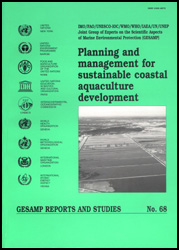 IMO/FAO/UNESCO-IOC/WMO/WHO/IAEA/UN/UNEP
IMO/FAO/UNESCO-IOC/WMO/WHO/IAEA/UN/UNEPJoint Group of Experts on the Scientific Aspects
of Marine Environmental Protection (GESAMP)
 IMO/FAO/UNESCO-IOC/WMO/WHO/IAEA/UN/UNEP
IMO/FAO/UNESCO-IOC/WMO/WHO/IAEA/UN/UNEP|
GESAMP REPORTS AND STUDIES |
No. 68 |
FOOD AND AGRICULTURE ORGANIZATION OF THE UNITED NATIONS
Rome, 2001
ISBN 92-5-104634-4
ISSN 1020-4873
© UN, UNEP, FAO, UNESCO, WHO, WMO, IMO, IAEA 2001
|
UNITED NATIONS |
|
UNITED NATIONS ENVIRONMENT PROGRAMME |
|
FOOD AND AGRICULTURE ORGANIZATION OF THE UNITED NATIONS |
|
UNITED NATIONS EDUCATION, SCIENTIFIC AND CULTURAL ORGANIZATION |
|
INTERGOVERNMENTAL OCEANOGRAPHIC COMMISSION |
|
WORLD HEALTH ORGANIZATION |
|
WORLD METEOROLOGICAL ORGANIZATION |
|
INTERNATIONAL MARITIME ORGANIZATION |
|
INTERNATIONAL ATOMIC ENERGY AGENCY |
Cover photo: Shrimp aquaculture ponds in Mexico.
Courtesy of Mr José Aguilar-Manjarrez, Fisheries Department, FAO, Rome.
ISBN 92-5-104634-4
ISSN 1020-4873
© UN, UNEP, FAO, UNESCO, WHO, WMO, IMO, IAEA 2001
For bibliographic purposes, this document should be cited as:
GESAMP (IMO/FAO/UNESCO-IOC/WMO/WHO/IAEA/UN/UNEP Joint Group of Experts on the Scientific Aspects of Marine Environmental Protection), 2001. Planning and management for sustainable coastal aquaculture development. Rep.Stud.GESAMP, (68): 90 p.
PART ONE: GUIDELINES FOR PLANNING AND MANAGEMENT FOR SUSTAINABLE COASTAL AQUACULTURE DEVELOPMENT
1.1.1 The status of aquaculture development
1.1.2 Sustainable Development
1.1.3 The costs and benefits of coastal aquaculture development
1.1.4 The need for planning and management of the aquaculture sector1.2 AQUACULTURE AND COASTAL MANAGEMENT - A BRIEF REVIEW OF THEORY AND PRACTICE
1.2.1 The scope of coastal management
1.2.2 Enhanced sectoral management (ESM)
1.2.3 Coastal zone and integrated coastal management
1.2.4 Lessons learned
1.2.5 Conclusions and recommendations1.3.1 Adherence to Rio Principles
1.3.2 Integration and co-ordination
1.3.3 Public involvement
1.3.4 Assessment of costs and benefits
1.3.5 Estimation of environmental capacity
1.3.6 Emphasis on incentives rather than constraints
1.3.7 Control of effects rather than scale of activity
1.3.8 Evaluation, iteration and adaptation
1.3.9 Effective institutions and representative organizations1.4 LEGAL AND INSTITUTIONAL FRAMEWORKS
1.5.1 Main stages
1.5.2 Operational components
1.5.3 Identifying the mechanism and level of planning
1.5.4 Gaining the trust, involvement and commitment of key stakeholders
1.5.5 Understanding the development context
1.5.6 Understanding the development options
1.5.7 Definition of goals and objectives
1.5.8 Identifying development priorities and preferred options
1.5.9 Conflict identification and resolution
1.5.10 Defining broad management strategy
1.5.11 Planning instruments: incentives and constraints
1.5.12 Monitoring, reporting, evaluation and response/adaptation procedures
1.5.13 Institutional arrangements and implementing structures
1.5.14 Formal adoption of the plan
1.5.15 Implementation and adaptation
1.5.16 Criteria for evaluation of integrating aquaculture into coastal management
2.1 INSTITUTIONAL AND STAKEHOLDER ANALYSIS
2.2.1 Rapid rural appraisal and participatory rural appraisal
2.2.2 Socio-economic survey2.3 REMOTE SENSING AND GEOGRAPHIC INFORMATION SYSTEMS
2.4 ASSESSMENT OF ENVIRONMENTAL CAPACITY AND LIMITS TO CHANGE2.4.1 General approach to estimating environmental capacity
2.4.2 Models of phytoplankton dynamics and environmental capacity
2.4.3 Models of the input of organic matter to the seabed
2.4.4 Tropical versus temperate systems
2.4.5 Relation to other components
2.4.6 Conclusions and recommendations2.5 TECHNICAL AND ECONOMIC ASSESSMENT
2.5.1 Screening
2.5.2 Location and siting requirements
2.5.3 Market assessment
2.5.4 Financial analysis
2.5.5 Risk assessment
2.5.6 Resource utilization and the generation of goods and services
2.5.7 Socio-economic characteristics
2.5.8 Sustainability profile
2.5.9 Technology assessment of aquaculture in practice2.7 ENVIRONMENTAL AND SOCIAL IMPACT ASSESSMENT
2.8 COST BENEFIT ANALYSIS (CBA)2.8.1 Experience review
2.8.2 Strengths and weaknesses
2.8.3 Conclusions and recommendations2.9 CONSULTATIVE AND PARTICIPATORY APPROACHES TO ALLOCATION DECISIONS
2.10 CONFLICT IDENTIFICATION AND RESOLUTION2.10.1 Arbitration
2.10.2 Mediation
2.10.3 Negotiation
2.10.4 Techniques
2.10.5 Pre-conditions2.11.1 Main applications
2.11.2 Main approaches
2.11.3 Main attributes
2.11.4 Experience
2.11.5 Strengths and weaknesses
2.11.6 Recommendations2.12 PLANNING INSTRUMENTS: INCENTIVES AND CONSTRAINTS
2.12.1 Administrative instruments
2.12.2 Economic instruments
2.12.3 Markets and labelling2.13.1 Ecological monitoring
2.13.2 Social and economic monitoring
2.13.3 Conclusions and recommendations